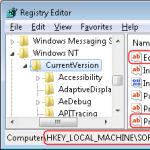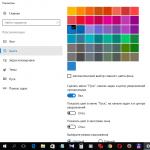Windows 7 downgrade Ultimate to Professional/HomePremium
There are situations when from the installation disk Windows7 22in1 The version of Windows that we need is not installed. And it's good if it's HomePremium or Professional, because do update before Ultimate will not be difficult. You just need to change the product key and Windows itself will do all the necessary operations. But what to do if you need to do the so-called Downgrade? Those. everything is the same, but in reverse order. Get from already installed Windows 7 Ultimate the one we need Professional or HomePremium.
So, for a successful so-called Downgrade, you first need to change 2 keys in the registry on an already installed Windows 7 Ultimate. This is a thread HKEY_LOCAL_MACHINE\SOFTWARE\Microsoft\Windows NT\CurrentVersion
In our installed Windows 7 Ultimate, this branch looks like this:
In order for us to receive Windows 7 HomePremium need to change EditionID on HOMEPREMIUM And ProductName on Windows 7 HOMEPREMIUM:

If we need Windows 7 Professional, then change the keys to Professional And Windows 7 Professional respectively:

After this we need to start update operating system from the installation disk. Exactly update, not a new installation.

For Downgrade to HomePremium We choose HomePremium from the proposed options:

Well, what if we downgrade to Professional, then we select it from the list of proposed options:

During the update process, the compatibility of components and software will be checked for a long time, after which the update itself will begin. The duration of this process depends on the amount of installed software in the system.

After this process, functions become unavailable Ultimate, available only to her, and when Windows starts, we already see our “downgraded” HomePremium or Professional:


Good luck. Everything you do, you do at your own peril and risk. I recommend making a system backup. For example, an image of a system disk using a special program
Hello admin! I want to update on my laptop Windows 7 Home Basic to Windows 7 Maximum (Ultimate). How can this be done without completely reinstalling the operating system?Home Basic Seven was installed on my laptop from the store and it is quite flawed in terms of what it doesn’t haveAero Peek, BitLocker, and much more, I can’t even change the wallpaper on it. I tried to update myself, but I got an error"To upgrade from an edition of Windows 7 to another edition of Windows 7, use the Windows Anytime Upgrade program." What is “Windows Anytime Upgrade” and where can I get it?
Hello friends! Our reader is right and Windows 7 Home Basic does not contain quite a lot of functions (network, mobile, enterprise, etc.), which may well be needed by experienced users or professional system administrators, but whether they are useful to the average user, let everyone decide for themselves. In today's article, I will show you how to update Windows 7 Home Basic on your computer without completely reinstalling the operating system. up to Windows 7 Professional or Ultimate , this is very easy to do, but you must have license keys for Win 7 PRO and Ultimate , if you don’t have them, then I’ll give you mine, I once bought the professional and maximum versions of the seven, these keys are only suitable for updating and will allow you to work in the system for 30 days without activation. I think in 30 days you will activate the OS. After the update, all your installed programs will work, and your personal files will remain in place.Before starting work, I advise you to make a backup copy of the OS.
So, we have a laptop with Windows 7 Home Basic installed.

Download “Windows 7 Upgrade Advisor” (Windows7UpgradeAdvisorSetup) from the official Microsoft website
if the site is unavailable, then download “Windows Anytime Upgrade” on my cloud storage.

Let's launch the Advisor.


After installation, open the “Start” menu and select “Windows 7 Upgrade Advisor,” which will diagnose our OS to see if we can upgrade to the next version.

"Start checking"

The result of the check says that an upgrade is available to us from Windows 7 Home Basic installed on our PC to Windows 7 Professional or Ultimate.


Now we launch “Windows Anytime Upgrade”.

Click “Enter update key”

Here you must enter your Windows 7 Professional license key. If you don’t have it, then take mine (VTDC3-WM7HP-XMPMX-K4YQ2-WYGJ8), it will be suitable for updating.

The license key is being checked.

We accept the license terms.

"Update"

The process of updating the system to the PRO version begins.



The update has been successfully completed!




Upgrading Windows 7 Professional to Windows 7 Ultimate
And now our OS can be updated to the Maximum version.
Launch Windows 7 Upgrade Advisor again

"Start checking"

The advisor is not against us updating to the Maximum version of the OS.

Launch "Windows Anytime Upgrade".

Click “Enter update key”.

You must enter your Windows 7 Ultimate license key. If you don't have it, then use the key (FJGCP-4DFJD-GJY49-VJBQ7-HYRR2).

The license key is being checked.

We accept the license terms.

"Update"

The process of updating the system to the Ultimate version begins.


As a result, we have Windows 7 Ultimate on our PC.

By introducing various editions of the Windows operating system to the market, the manufacturer implies that the user will choose the edition that best suits his needs and financial capabilities. However, in life everything is different: ready-made PCs usually come with a pre-installed system of the simplest (and cheapest) edition, and unlicensed users, without bothering too much, install one of the older editions. All this often leads to the fact that the Windows edition needs to be changed, preferably without reinstalling the system.
The main problem is that the user is faced with the need to change the Windows edition when the system is already “lived in”: the necessary software and equipment are installed and configured, data is laid out in the usual way, etc., etc.
There are two scenarios for changing the edition. One of them can be conditionally called “official”. Microsoft supports the transition from minor to senior editions quite officially. It is enough to purchase a special key or box.
It’s worse when the editorial team needs to be demoted. This usually happens when licensing pirated versions, when boxes or licenses of the required edition are purchased, which does not coincide with what is actually on computers. Officially, Microsoft does not support such changes and recommends installing the system from scratch, but there is one undocumented possibility that we will consider.
Everyone knows that if you run the Windows installer on a loaded OS, then one of the available options will be to update the system while preserving all installed applications and settings.
 However, such an update is only possible if the edition of the installed system matches the edition of the distribution, otherwise we will only be offered a new installation:
However, such an update is only possible if the edition of the installed system matches the edition of the distribution, otherwise we will only be offered a new installation:
 There are no official ways to get around this limitation, so it's time to turn to undocumented possibilities. We find it difficult to imagine why Microsoft does not support arbitrary changes to the Windows edition by entering the appropriate key and/or updating using the distribution kit of the desired edition, especially since there are no technical obstacles here.
There are no official ways to get around this limitation, so it's time to turn to undocumented possibilities. We find it difficult to imagine why Microsoft does not support arbitrary changes to the Windows edition by entering the appropriate key and/or updating using the distribution kit of the desired edition, especially since there are no technical obstacles here.
Empirically, it was found that the installer receives information about the system edition from the registry branch:
HKEY_LOCAL_MACHINE\SOFTWARE\Microsoft\Windows NT\CurrentVersionas a parameter value EditionID. To successfully update with a change of edition, we need to change this parameter so that it matches the edition of the target distribution.
 Some sources also recommend changing the parameter ProductName, however, this is completely unnecessary. After change EditionID You should perform the update immediately without rebooting the system. This method is suitable for all current Windows client systems and below we will consider compliance EditionID editions of the operating system.
Some sources also recommend changing the parameter ProductName, however, this is completely unnecessary. After change EditionID You should perform the update immediately without rebooting the system. This method is suitable for all current Windows client systems and below we will consider compliance EditionID editions of the operating system.
Windows 7
This version of Windows has the largest official number of editions, but the naming system is simple and clear, which makes it easy to identify the one you need. For Windows 7 the following values are valid EditionID depending on edition:
- Starter- The initial, most limited edition, was distributed only in the OEM channel, most often with netbooks
- HomeBasic- Home Basic
- HomePremium- Home extended
- Professional- Professional
- Ultimate- Maximum
- Enterprise- Corporate, distributed only under the volume licensing program
All editions, except for the Starter and Corporate editions, were available both at retail and through OEM channels, differing in nothing except the type of license, but you will not be able to update from the OEM distribution using the key from the boxed version and vice versa.
Windows 8.1
At first glance, there are fewer editions of Windows 8, just Basic, Professional and Enterprise. But in fact, Microsoft managed to segment them in such a way that, in fact, the editions of Windows 8.1 and acceptable values EditionID it turned out to be even more:
- Core- Basic
- CoreSingleLanguage- Basic for one language, OEM only
- ConnectedCore- Basic with Bing, free for major OEMs
- CoreConnectedSingleLanguage- Basic with Bing for one language, for manufacturers only
- Professional- Professional
- ProfessionalWMC- Professional with Windows Media Center
- Enterprise
As we can see, there are four Basic editions alone, although you can purchase only two of them at retail or as an OEM supply: Basic and Basic for one language. The versions with Bing are only available to manufacturers, and you can only get it with hardware. However, you may need to revert to this version if you uninstalled the pre-installed version and now want to return the license. In this case, you will need to find an installation distribution, which is quite difficult (they are not and never were publicly available).
Windows 10
The situation with Windows 10 tends to completely repeat the history of Windows 8.1; three editions are also officially announced: Home, Professional and Enterprise. In reality, there are more editions; Home is already available for one language and, perhaps, other options will appear.
At the moment, we can talk about four editions, but this list does not pretend to be complete and will be updated as information becomes available.
- Core- Home
- CoreSingleLanguage- Home for one language, OEM only
- Professional- Professional
- Enterprise- Enterprise, only in the volume licensing channel
To keep the above data current and timely update, we ask our readers, especially those who purchased devices with pre-installed Windows 10 or updated pre-installed versions of Windows 8.1, to check the meaning of the keys EditionID And ProductName, and publish the results, if they differ from the above list, in the comments.
Often, users who do not have the skills necessary to install, update or configure an operating system on their own buy a computer or laptop with a certain version of the OS already installed by the gadget manufacturer. True, almost always the installed operating system turns out to be a stripped-down edition of Windows 7 - Starter, Home Basic or Home Premium. The functionality of this edition is limited, and it may not always be enough for comfortable work. In this case, to upgrade the current release to a more functional one, you can use a special utility called Window anytime upgrade (WAU).
Determining the current edition of Windows
The very first step should be to determine the edition of the operating system installed on the PC, its version and bit depth, as well as the capabilities that this edition provides to the user. To do this, go to “System Properties” by right-clicking on the “My Computer” desktop shortcut and selecting the “Properties” menu item. Here you can see the type of installed OS, its version and other necessary data. You can familiarize yourself with the functionality of each edition on the official Microsoft website in a special section that tells in detail about the existing versions of Windows.

Limitations of the Window anytime upgrade utility
Those who decide to use the WAU OS functionality extension utility should know that it has several significant limitations:
Using the program, you can update the edition only within one bit depth: 32-bit to 32-bit, and 64-bit to 64-bit, respectively;
Initially, the utility does not work in the Maximum and Enterprise editions of Windows 7 (however, there is a way to bypass this limitation, which can be found below);
The utility is designed to perform updates only between releases of Windows, and with its help it is impossible to update from previous versions of the OS.
Windows editions can be divided into levels according to the available functionality in each of them:
- 1st level: Beginner, or Home Basic.
- Level 2: Home Extended.
- Level 3: Professional.
- Level 4: Maximum.
Increases are made based on increasing functionality. Thus, for example, the Basic edition can be upgraded to any of the subsequent, more functional ones, but the Professional edition can only be upgraded to the Maximum edition.
It is also worth considering that during the update process only additional functions are added, which is unlikely to affect the speed of the PC, and the extended edition will not lead to an increase in its performance.
Windows 7 anytime upgrade: getting new OS features
Before using the utility, you need to make sure that your computer has all the necessary updates from Windows Update, as well as the latest “Service Pack”.
The WAU utility will require a stable Internet connection, as well as a Window anytime upgrade key purchased through a retail store.

To start the program, you need to go to “System Properties” through the control panel or the context menu of the “My Computer” icon and select “Gain access to additional features by installing a new edition of Windows 7.” Next, the system will ask you to enter the WAU key, offer to read the terms and conditions and display the “Update” button, which you should click on. The update process may take up to half an hour, during which the OS will reboot several times. As a result, the required edition of Windows 7 will be installed on the computer.

Downgrading Windows 7
One of the main reasons for downgrading a publication may be the transition from a pirated “professional” edition to a licensed one. It may be more stripped down, but user settings and updates are not lost during the transition. Windows anytime upgrade allows you to do this, but you will need to do some additional steps as the installer checks the edition before upgrading.
In order for the utility to successfully pass the compatibility check, you must use the Registry Editor to change the value of the installed OS edition.

In the HKEY_LOCAL_MACHINE section, you need to go to the SOFTWARE\Microsoft\Windows NT\CurrentVersion path and change the EditionID parameter to the one corresponding to the edition you are installing: Starter, Home Basic, Home Premium, Professional, Ultimate or Enterprise.
Next, using the Window anytime upgrade utility, you need to select the “Update. Change edition of Windows 7." After the update process is completed, a new edition of the operating system will be installed on the PC, preserving all applications and settings of the previous one.



